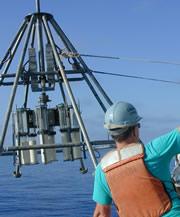 Surveys of the tropical Atlantic Ocean have revealed the Gulf Stream's past behaviour.Dorinda Ostermann
Surveys of the tropical Atlantic Ocean have revealed the Gulf Stream's past behaviour.Dorinda OstermannThe Gulf Stream — the ocean current that helps to bring warm weather to much of the North Atlantic region — was significantly weakened during the period known to historians as the Little Ice Age, new research reveals.
The discovery supports the notion that a slowing of ocean currents — as some fear might happen in our future — can have significant consequences for climate.
From around 1200 until 1850, during which average temperatures across the Northern Hemisphere dipped by around 1 °C, the strength of the Gulf Stream also slackened by up to 10%, oceanographers report.
“This gives us some sense of the natural range in strength. If the change is greater in the future then maybe that will mean something unusual is happening.”
David Lund, California Institute of Technology
The Gulf Stream, which is part of a vast pattern of currents nicknamed the ocean conveyor belt, carries warm surface waters from the tropical Atlantic northeastwards towards Europe. The reduced flow that occurred during medieval times would have transported less heat, contributing to the icy conditions that persisted until Victorian times.
"This gives us some sense of the natural range in strength. If the change is greater in the future then maybe that will mean something unusual is happening," says David Lund of the California Institute of Technology in Pasadena, who led the research while based at the Massachusetts Institute of Technology and the Woods Hole Oceanographic Institution.
Weakened waters
A weakening Gulf Stream has been predicted to have dire consequences for temperate climates in the Northern Hemisphere. But oceanographers say that it is very unlikely to shut down, as depicted in the Hollywood blockbuster The Day After Tomorrow. "That's definitely an absurdity," Lund says.
But the new research by Lund's group shows what can happen if the Gulf Stream is weakened. He and his colleagues studied the remains of tiny animals called foraminifera in sediments off the coast of Florida, where currents feed into the Gulf Stream. Changes in the composition of oxygen isotopes in their shells reflect changes in water temperature and salinity, which in turn reveals the density of the water they were living in.
Mapping the water density between Florida and the Bahamas gives the researchers a picture of how fast the current was moving between them. Lund and his team report their results, which extend back some 1,000 years, in this week's Nature1.
Fresh or salty
Lund and his colleagues think that the Gulf Stream's weakening was caused by a southward shift of the zone of tropical rains that usually feed fresh water into the Atlantic Ocean off the coast of Florida. This rain provides a less-dense top layer of water that bolsters the surface current flowing north. Their measurements show that, during times when the current was weakest, the waters were saltier, suggesting that they contained less fresh water from rain.
The slowing of the current this way can fix itself, however — the extra saltiness of the water should help the water to sink at the northern end of its cycle, Lund says, driving the bottom half of the ocean circulation and re-energizing the current.
This process is in contrast to current fears about the Gulf Stream. Climatologists are worried that continued melting of the Greenland ice sheet could dump too much fresh water into the northern end of the circulation system, where cold waters normally sink and drive the bottom half of the current — dense waters flowing south along the ocean floor. Too much fresh water in the north makes the water less dense and less likely to sink, slowing the current.
Some fear that this process would not fix itself, but rather lead to a runaway effect that slows the current even more severely.
ADVERTISEMENT
Researchers measuring the ocean currents today say that the Gulf Stream shows no clear signs of slowing. Last month, a scientific meeting on the issue resulted in media reports that the Gulf Stream had shut down completely for 10 days in 2004. But as Harry Bryden of the University of Southampton, who led that study, explains, the temporary shutdown actually occurred in deeper currents that form just part of the complex circulation system. The Gulf Stream, he says, was unaffected. "The Gulf Stream seems rather robust to us," he adds.
But big changes could lie in our future. "Now, with the amount of carbon dioxide in the atmosphere, we're in a 'no analogue' situation," Lund says. With the world warming and the poles melting, it's impossible to say what might happen to the currents. "We just don't know."
Visit our streamweakenedinlittle.html">newsblog to read and post comments about this story.
-
References
- Lund C., Lynch-Stieglitz J.& Curry W. B., . Nature, 444 . 601 - 604 (2006). | Article |
